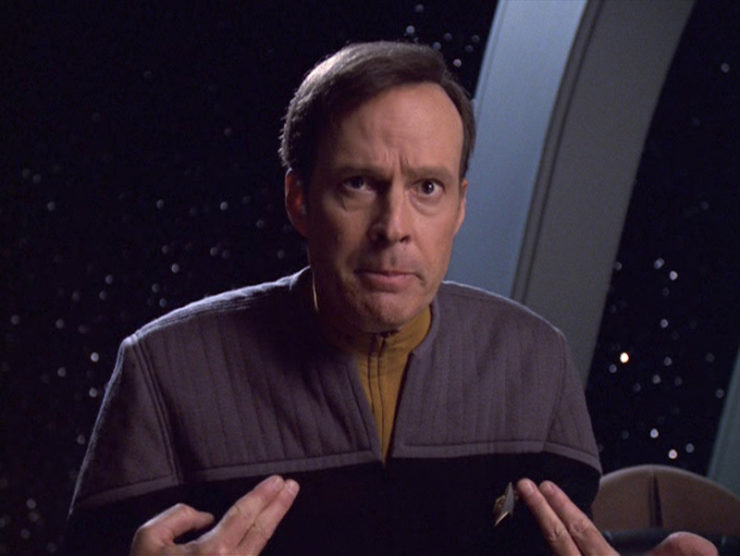“Pathfinder”
Written by David Zabel and Kenneth Biller
Directed by Mike Vejar
Season 6, Episode 10
Production episode 230
Original air date: December 1, 1999
Stardate: unknown
Captain’s log. Barclay is unpacking haphazardly in his apartment, working around his cat—named Neelix—when he gets a visitor: Troi. The Enterprise is in orbit of Earth, and Barclay has asked Troi to drop by to talk. He says he’s becoming obsessed with Voyager.
Two years ago, Barclay transferred from the Enterprise to the Pathfinder Project, under the direction of Commander Pete Harkins. They have been trying to find a way to communicate with Voyager ever since they made contact through the Hirogen communications array.
They made one attempt to create a transwarp probe, which failed. Barclay has been putting in long hours at the project—which is why he still hasn’t unpacked two years after moving back to Earth—and because his transwarp probe failed, Harkins is reluctant to approve his notion of using an itinerant pulsar to create a wormhole.
They’ve re-created Voyager on the holodeck, complete with personnel, based on what the EMH reported to Starfleet Command. (Amusingly, the program has Chakotay as first officer and Torres as chief engineer, but they’re wearing civilian clothes. The EMH didn’t say that the Maquis crew are all in uniform. Also Janeway still has longer hair tied in a bun in the simulation.) Harkins finds Barclay futzing with stuff in the simulation and not actually working on the diagnostic Harkins assigned to him. Admiral Owen Paris is coming to inspect the project the next day, and everything needs to be ready to go.
Harkins doesn’t want Barclay to speak during the admiral’s visit. He also offers dinner at his place—his sister-in-law is in town, and Harkins thinks she and Barclay will get along. But Barclay declines, preferring to spend the night with his cat. Though, in fact, he doesn’t spend the night at home at all, but on the Voyager simulation. He’s given the crew personalities that enable him to converse with them, play poker with them, and bounce ideas off them. They also rarely pass up an opportunity to tell Barclay how awesome he is.
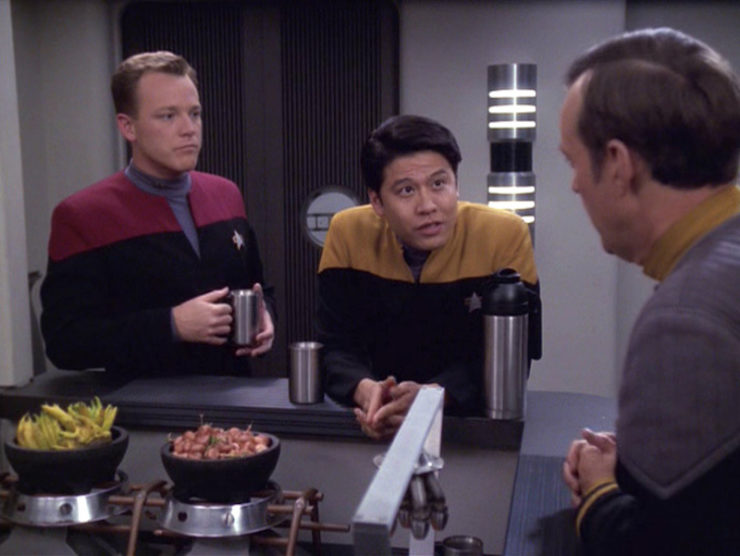
Owen arrives for his inspection. First Harkins explains that plan to use the MIDAS Array, provided by the Vulcans, to send a hyper-subspace transmission. It will enable them to communicate with Voyager though the ship won’t be able to respond. Barclay is unable to help himself from proposing his plan of opening a wormhole. Harkins points out the flaws in the plan, and Barclay loses it, saying that they have to try everything, and that maybe they’ve forgotten that there are 150 people trapped out there.
Paris rather tartly points out that his son is one of those people, and he thinks about it every day. Barclay at least has the good grace to look incredibly abashed at his spectacular insensitivity.
Harkins sends him home for the day, but instead Barclay goes to the holodeck to bounce ideas off his holo-Voyager crew. He hits on scaling things down: creating a micro-wormhole. Harkins finds him on the holodeck, distressed that he’s spent his mandated time off continuing to work. Both Harkins in the past and Troi in the present are concerned that Barclay’s holo-addiction is coming back to the fore. Barclay insists that it isn’t.
He goes to Owen (hovering outside his office frightening his aide until the admiral finally lets him in) to pitch his idea, which puts Owen in an awkward position, as he got a report from Harkins that Barclay was removed from the project.
In the present, Barclay begs Troi to certify him fit for duty so he can get back to it, but Troi is genuinely worried about him—so much so that she requests a leave of absence from the Enterprise, so she can spend time with a friend, and help him through this. Barclay is at once embarrassed, touched, and frustrated.
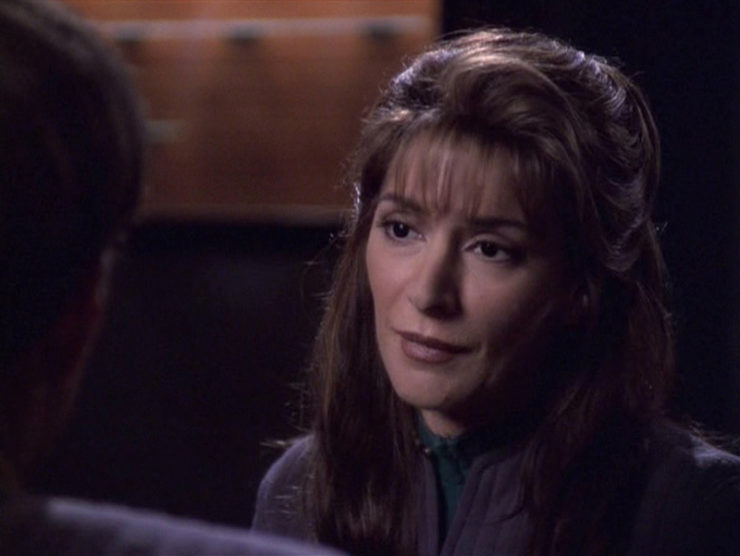
Barclay breaks into the lab with the greatest of ease (unsurprisingly, his access code no longer works). He puts his micro-wormhole notion into practice. When Harkins breaks in on him partway through his third attempt to contact Voyager, he retreats to the holodeck, where he locks out the controls. Harkins sends security after him, but Barclay is able to evade them (aided by the holographic Tuvok and Torres). Harkins finally decides to go into the holodeck and initiate a warp-core breach in the simulation, which will end it.
Barclay ends the program, and Harkins escorts him back into the lab—just as Owen arrives. He was going to approve Barclay’s plan, but he’s already implemented it against orders. Just as Harkins is about to have him put in the brig, Voyager replies to Barclay’s most recent communication. They’ve found them!
They all exchange information in the few minutes they have before the micro-wormhole collapses. Paris is gobsmacked to hear his father’s voice, and Barclay, Harkins, and Owen reassure the crew that they’ll continue to work to stay in touch, at least.
Barclay’s sins are forgiven and he remains under Harkins’ command under what is now called Project Voyager. Barclay also took Harkins up on his invitation to dinner with his family…
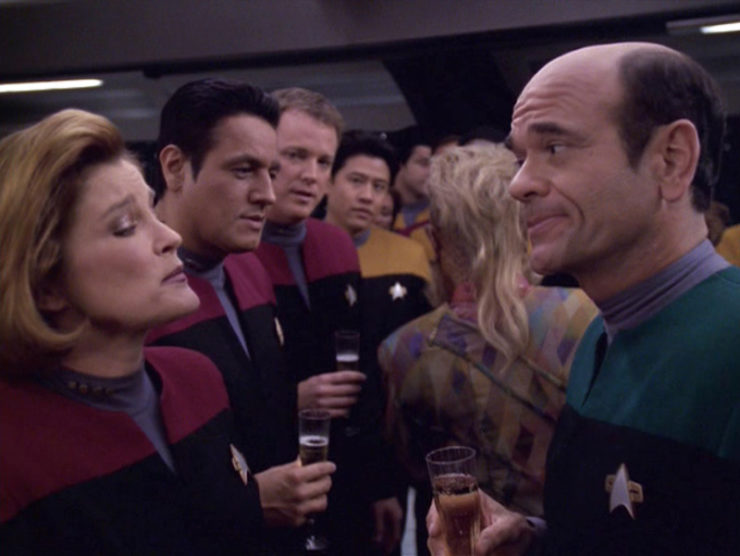
Can’t we just reverse the polarity? Okay, seriously, the Pathfinder Project is full of Starfleet engineers, who are known for being able to work miracles with any piece of equipment. Why would they only secure their lab with an access code? If anything should have a good old-fashioned mechanical padlock, it’s a Starfleet engineering lab…
There’s coffee in that nebula! Janeway tells Owen that her crew’s performance has been exemplary during their Delta Quadrant sojourn. At no point does she mention the crew members who’ve died since “Message in a Bottle” (they’ve lost at least five since that episode, depending on how many actually perished in “The Killing Game, Part II“). You’d think she’d want their families told, at least…
Mr. Vulcan. The holographic Tuvok stops participating in the poker games with Barclay because he doesn’t like to lose, apparently. Just as Seven’s hypothetical Tuvok was devious last time, Barclay’s hypothetical Tuvok is, apparently, whiny.
Half and half. The holographic Torres is Barclay’s most oft-used sounding board, probably because she’s (a) an engineer and (b) an attractive woman.
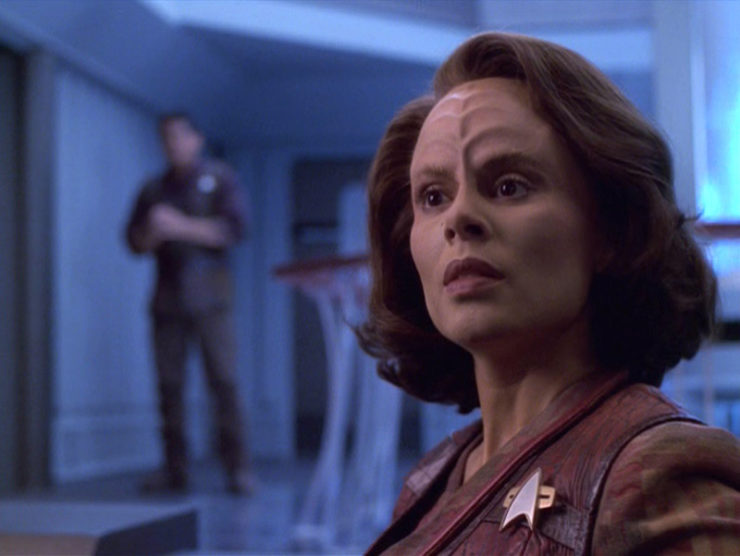
Everybody comes to Neelix’s. Neelix isn’t part of Barclay’s simulation, probably because he doesn’t know what Talaxians look like, but he does name his cat after the morale officer.
Please state the nature of the medical emergency. The EMH blithely reveals private medical information about Barclay to the crew in the mess hall, which violates whatever Starfleet’s equivalent of HIPAA is. He also fails to mention that he encountered an image of Barclay when his program went wonky in “Projections.”
Resistance is futile. Seven also isn’t part of Barclay’s simulation, for similar reasons to why Neelix isn’t. She’s the one who first detects Barclay’s signal and identifies it.
No sex, please, we’re Starfleet. Barclay and Harkins’ sister-in-law get along well on their first meeting—for one thing, she’s also a cat person…
What happens on the holodeck stays on the holodeck. I know I’ve complained a lot about the entire notion of holodeck safeties that can be disengaged, so let me point out that the safeties work just fine in this episode, and it’s very funny to see the holographic Torres shoot the security guards and absolutely nothing happens to them.
Do it.
“Has it ever occurred to you that a tachyon beam directed at a Class-B itinerant pulsar could produce enough gravimetric energy to create an artificial singularity?”
“I can’t say it has.”
–Barclay bringing the technobabble and Troi refusing delivery of same.
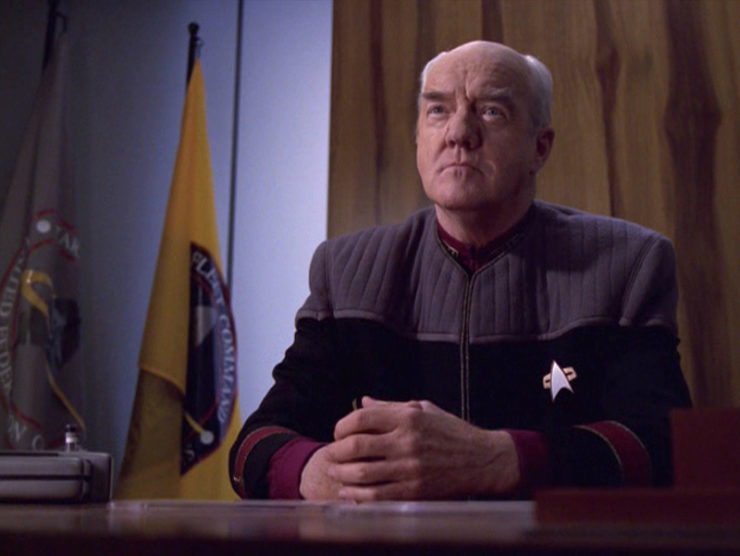
Welcome aboard. The great Richard Herd, who previously played L’Kor in TNG’s “Birthright” two-parter, takes over the recurring role of Owen Paris, which he will continue to play through to the end of the series. Richard McGonagle, who previously played Ja’Dar in TNG’s “New Ground,” plays Harkins. Both will next be seen in “Inside Man.”
The big guests here, though, are Dwight Schultz as Barclay and Marina Sirtis as Troi, returning to the roles they created on TNG. This is Schultz’s second appearance on Voyager, having played the image of Barclay in “Projections.” Both will next be seen in “Life Line.”
Trivial matters: While they are not seen, Troi makes mention of the Enterprise, Data, his cat Spot, and La Forge.
Somehow, Pathfinder extrapolates Voyager’s general location, based on where they were in “Message in a Bottle,” despite the fact that they’ve made several leaps forward (“Hope and Fear,” “Night,” “Timeless,” “Dark Frontier,” and “The Voyager Conspiracy”) that Starfleet could not possibly have accounted for.
Barclay’s holo-addiction was introduced in the character’s first appearance in TNG’s “Hollow Pursuits.” He started his counseling sessions with Troi then.
There has been a significant amount of Trek fiction that takes place in the year following DS9’s finale, which corresponds to the sixth season of Voyager and also the Pathfinder Project. Several novels and stories taking place in the Alpha Quadrant make use of the communication with Voyager that begins in this episode.
In “Thirty Days,” Paris set his letter to Owen to be sent when Voyager next contacts Starfleet Command, which happens in this episode, so one wonders if the letter went through when Barclay made contact.
This episode takes place roughly a year after San Francisco was attacked by the Breen in DS9’s “The Changing Face of Evil.” The city, Starfleet HQ, and the Golden Gate Bridge all appear to have been reconstructed.
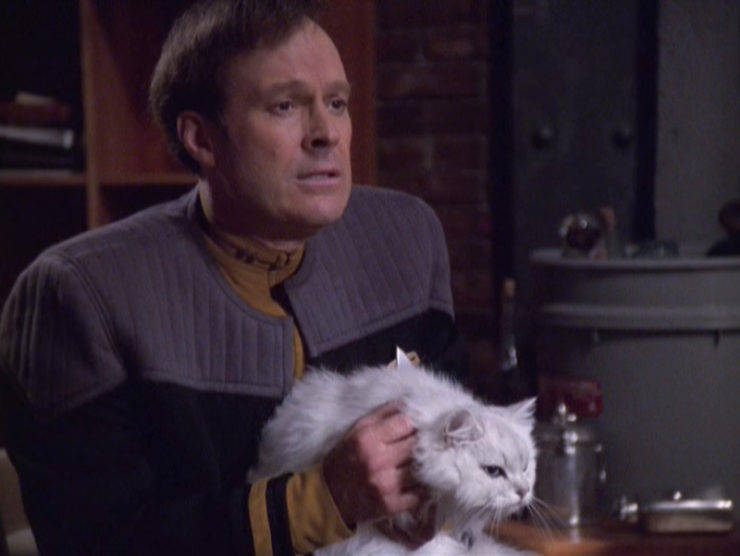
Set a course for home. “Keep a docking bay door open for us.” I joked with a friend that my latest Voyager Rewatch was a really good TNG episode, and I was only half-kidding. There are a lot of ways that this feels like it isn’t really a Voyager episode, so much as it is continuing Barclay’s arc that ran through the third, fourth, fifth, sixth, and seventh seasons of TNG.
And yet, it’s very much a Voyager episode, in the same way that “Distant Origin” was. It’s still about the journey Voyager is on to try to get home, but seen through the lens of someone outside the ship.
Those two elements combine to make this an excellent Star Trek episode, because it sets Voyager in a place it rarely goes: within the history and setting of the greater Trek universe. This is only the third time Voyager has made contemporary contact with the Alpha Quadrant (caveat necessary thanks to “Eye of the Needle”), and of the other two, one happened off camera (the EMH’s report to Starfleet in “Message in a Bottle”) and the other was one-way: letters from home (“Hunters”) and an encrypted message from Admiral Hayes (“Hope and Fear”). This is real contact that, unlike the others, has the promise of more.
The one thing Voyager has shown very little of is how the Alpha Quadrant responded to their disappearance and rediscovery in “Message in a Bottle.” Here we get that, partly through Owen’s desire to see his son again—he gets to stand in for all the families left behind, and Richard Herd’s hangdog mien serves him well here, as he exudes a very quiet and subtle desperation—mainly through Barclay’s obsession.
What I love about Barclay’s arc from “Hollow Pursuits,” through his other TNG appearances and to here is that there’s progress, but it’s not all at once. Dramatic fiction has a tiresome tendency to have psychological issues either all solved at once or never solved at all, but a combination of excellent writing and brilliant acting by Dwight Schultz has shown a continuum, as Barclay has slowly gotten more social, less obsessive—but it’s not all at once, and the old behaviors still crop up. We see some of the low-self-confidence programming in the Voyager simulation as, just like the Enterprise crew in “Hollow Pursuits,” the holographic characters all do whatever they can to feed Barclay’s ego and reassure him that he’s awesome, mostly because Barclay can’t bring himself to believe it outside the holodeck.
And, in true Trek fashion, the people around him try to help. Harkins could easily have been written as a hardass, but he’s genuinely concerned about Barclay. His rebuking him is not just out of concern for the efficacy of the project, but concern for Barclay’s own mental health, and the latter is actually more important than the former. And Troi is her usual supportive self, effortlessly moving back and forth between friend/confidante and counselor/therapist.
All of it is nicely in service of moving Voyager’s story forward. It gets dinged a point for the rather major plot hole that there just no way Starfleet could possibly extrapolate their current position given all the big-ass jumps the ship has taken in the previous two years. But at least they’re closer to home in more ways than one.
Warp factor rating: 9
Keith R.A. DeCandido is making his first in-person convention appearance of 2021 at Pensacon in Pensacola, Florida (hilariously, his last in-person convention before the recent apocalypse was also Pensacon at the end of February 2020). He’ll be at the Bard’s Tower booth, E6 on the vendor floor, alongside fellow Trek scribes Melinda M. Snodgrass and Peter David, as well as Dan Wells, Christopher Ruocchio, Rick Heinz, Marion G. Harmon, Megan Mackie, T. Allen Diaz, Brian Anderson, and James Garner and voice actor Carlos Ferro, and will also be doing a panel on writing Star Trek with Peter, Melinda, and Tony Isabella Friday at 1pm. Come by and say hi!










